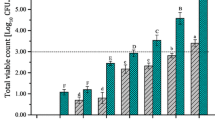Abstract
Changes in riboflavin content of industrially bottled palm juice stored at different light intensities similar to display patterns practised by traders was studied. The loss of riboflavin in the first 24 hours was significantly higher than in the second 24 hours in both transparent (P<0.001) and green bottles (P<0.02) exposed to bright sunlight. Riboflavin loss from samples stored in transparent bottles occurred at a faster rate (24–71% of initial) than from samples in green bottles (0–29%) over a 36-hour period. Further loss of riboflavin did not occur over the next 36 hours due to cool weather conditions. In contrast, only 6% of initial riboflavin was lost after 72 hours of continuous exposure to fluorescent light: this increased by 53% by the ninth week. The data showed that riboflavin loss from bottled palm juice varied with the container, the environmental conditions and period of storage. It is recommended that palm juice should be displayed in dark bottles and protected from bright light.
Similar content being viewed by others
References
Ajayi OA, James OA (1984) Effect of riboflavin supplementation on riboflavin nutriture of a secondary school population in Nigeria. Am J Clin Nutr 39:787–791
Ajayi OA (1984) Biochemical ariboflavinosis among Nigerian rural school children. Human Nutr Clin Nutr 38C:383–389
Association of Official Agricultural Chemists (1970) Official methods of analysis, 10th Ed. Washington DC: Association of Official Agricultural Chemists
Bamji MS, Arya S, Rameshwar Sarma KV, Radhaiah G (1982) Impact of long term, low dose B-complex vitamin supplements on vitamin status and psychomotor performance of rural school boys. Nutr Res 2:147–153
Dimler RJ, Altschul AM, Planch RW, Geddes WF, Stewart RA, Liener JE (1960) Effects of commercial processing of cereals on nutrient content. In: Harris RS, Van Loesecke H (eds) The Nutritional Evaluation of Food Processing. New York, John Wiley and Sons, Inc., pp 197–237
Morgan AF, Harris RS, Levenberg RK (1960) Losses of nutrients in foods during home preparation. In: Harris RA, Von Loesecke H (eds) New York John Wiley and Sons, Inc., pp 442–491
Noble I (1970) Thiamine and riboflavin retention in cooked variety meats. J Am Diet Assoc 56:225–228
Singh RD, Heldman DR, Kirk JR (1975) Kinetic analysis of light-induced riboflavin loss in whole milk. J Food Sci 40:164–167
Sterner RT, Price WR (1973) Restricted riboflavin: within subject behavioural effects in humans. Am J Clinical Nutr 26:150–160
Wanner RL (1960) Effects of commercial processing of milk and milk products on their nutrient content. In: Harris RS, Von Loesecke H (eds) The Nutritional Evaluation of Food Processing. New York John Wiley and Sons, Inc., pp 173–196
Author information
Authors and Affiliations
Rights and permissions
About this article
Cite this article
Ajayi, O.A., Oladapo, G.O. Display practices and changes in riboflavin content of non-fermenting palm juice. Plant Food Hum Nutr 36, 197–200 (1986). https://doi.org/10.1007/BF01092037
Received:
Revised:
Issue Date:
DOI: https://doi.org/10.1007/BF01092037




